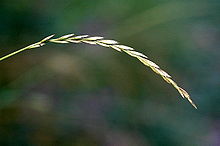- Elytrigia repens
-
Elytrigia repens 
Scientific classification Kingdom: Plantae (unranked): Angiosperms (unranked): Monocots (unranked): Commelinids Order: Poales Family: Poaceae Genus: Elytrigia Species: E. repens Binomial name Elytrigia repens
(L.) Desv. ex NevskiElytrigia repens (couch grass; syn. Triticum repens L., Agropyron repens (L.) P. Beauv., Elymus repens (L.) Gould) is a very common perennial species of grass native to most of Europe, Asia, and northwest Africa. Other names include twitch, quick grass, quitch grass (also just quitch), dog grass, quackgrass, scutch grass, and witchgrass.[1][2][3][4]
Contents
Description
It has creeping rhizomes which enable it to grow rapidly across grassland. The stems ('culms') grow to 40–150 cm tall; the leaves are linear, 15–40 cm long and 3–10 mm broad at the base of the plant, with leaves higher on the stems 2–8.5 mm broad. The flower spike is 10–30 cm long, with spikelets 1–2 cm long, 5–7 mm broad and 3 mm thick with three to eight florets. The glumes are 7–12 mm long, usually without an awn or with only a short one.
It flowers at the end of June through to August in the northern hemisphere.[2][3][5]
[6].
Taxonomy
There are three subspecies, one of these with an additional variety:[1][2][3]
- Elytrigia repens subsp. repens. Throughout most of the range of the species.
- Elytrigia repens subsp. repens var. repens. Awns usually absent or if present, very short.
- Elytrigia repens subsp. repens var. aristata (Döll) P.D.Sell. Awns present, up to 15 mm long.
- Elytrigia repens subsp. elongatiformis (Drobow) Tzvelev (syn. Elytrigia elongatiformis (Drobow) Nevski). Central and southwestern Asia, far southeastern Europe (Ukraine).
- Elytrigia repens subsp. longearistata N. R. Cui. Western China (Xinjiang).
Hybrids are recorded with several related grasses, including Elytrigia juncea (Elytrigia × laxa (Fr.) Kerguélen), Elytrigia atherica (Elytrigia × drucei Stace), and with the barley species Hordeum secalinum (× Elytrordeum langei (K. Richt.) Hyl.).[2]
Ecology
The foliage is an important forage grass for many grazing mammals.[3] The seeds are eaten by several species of grassland birds, particularly buntings and finches.[7] The caterpillars of some Lepidoptera use it as a foodplant, e.g. the Essex Skipper (Thymelicus lineola).
Cultivation and uses
Couch Grass has become naturalised throughout much of the world, and often listed as an invasive weed.[1] It is very difficult to remove from garden environments,as each piece of rhizome can develop into a new plant. One method is to dig deep into the ground in order to remove as much of the grass as possible. The area should then be covered with a thick layer of woodchips. To further prevent re-growth cardboard can be placed underneath the woodchips. The long, white rhizomes will, however, dry out and die if left on the surface. Many herbicides will also control it.
Medical use
Couch Grass has been used in herbal medicine since the Classical Greek period. Sick dogs are known to dig up and eat the root,[citation needed] and mediaeval herbalists used it to treat inflamed bladders, painful urination and water retention. It also has antiseptic properties.[8][9]
Other uses
The dried rhizomes of couch grass were broken up and used as incense in mediaeval Northern Europe where other resin-based types of incense were unavailable.
Notes
- ^ a b c Germplasm Resources Information Network: Elytrigia repens
- ^ a b c d Flora of NW Europe: Elytrigia repens
- ^ a b c d Flora of China: Elytrigia repens
- ^ Webster Third International Dictionary (Könemann, 1993) ISBN 3-8290-5292-8
- ^ Fitter, R., Fitter, A., & Farrer, A. (1984). Collins Guide to the Grasses, Sedges, Rushes and Ferns of Britain and Northern Europe. Collins ISBN 0-00-219128-8.
- ^ Grasses by C E Hubbard, 1978, published by Penguin books
- ^ Snow, D. W. & Perrins, C. M. (1998). The Birds of the Western Palearctic Concise Edition. OUP ISBN 0-19-854099-X.
- ^ Plants for a Future: Elytrigia repens
- ^ Howard, Michael. Traditional Herbal Remedies (Century, 1987): p.127.
External Links
- Species Profile- Quackgrass (Elymus repens), National Invasive Species Information Center, United States National Agricultural Library. Lists general information and resources for Quackgrass.
Categories:- Pooideae
- Flora of Europe
- Medicinal plants
- Demulcents
- Invasive plant species
- Butterfly food plants
Wikimedia Foundation. 2010.




